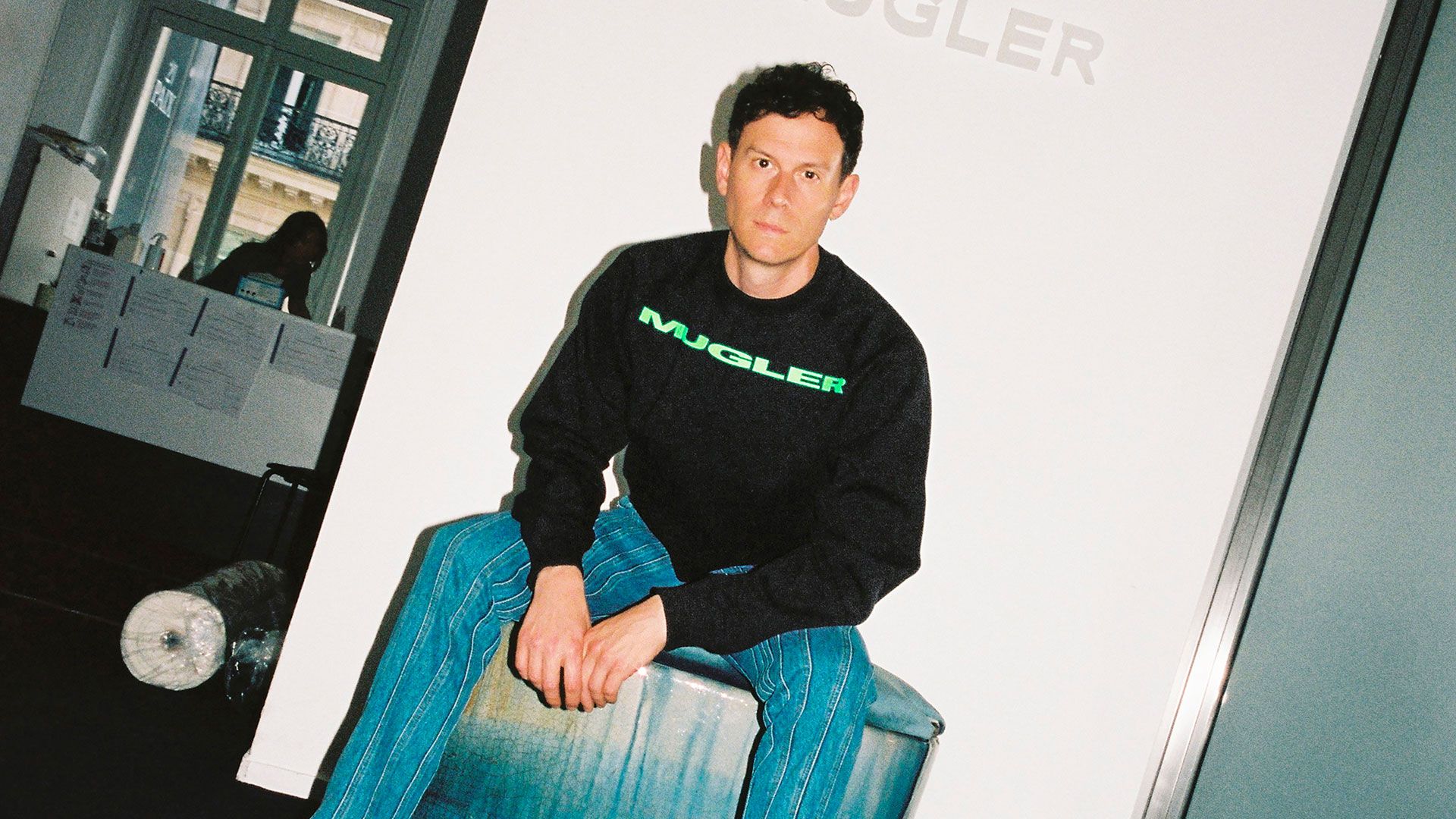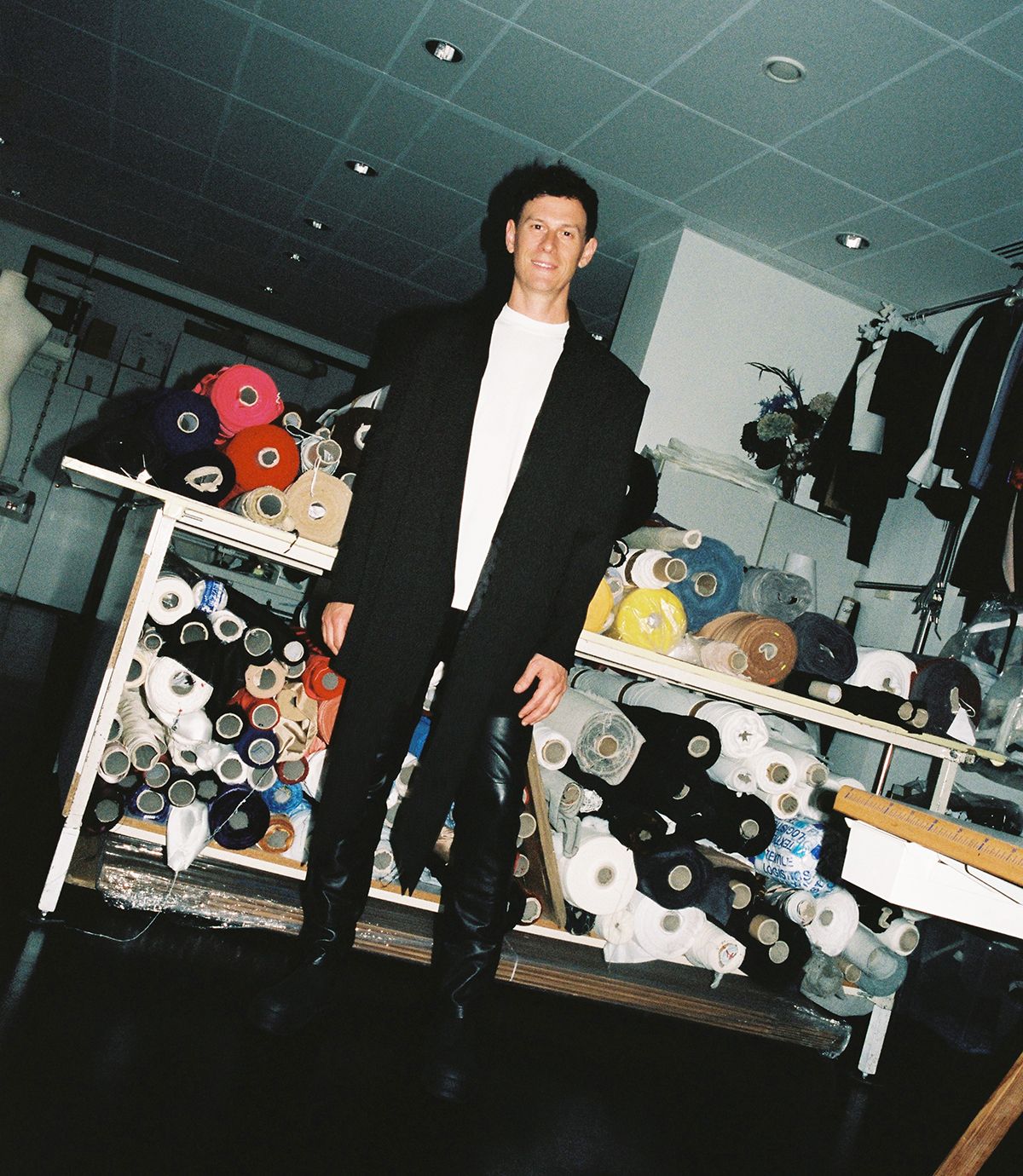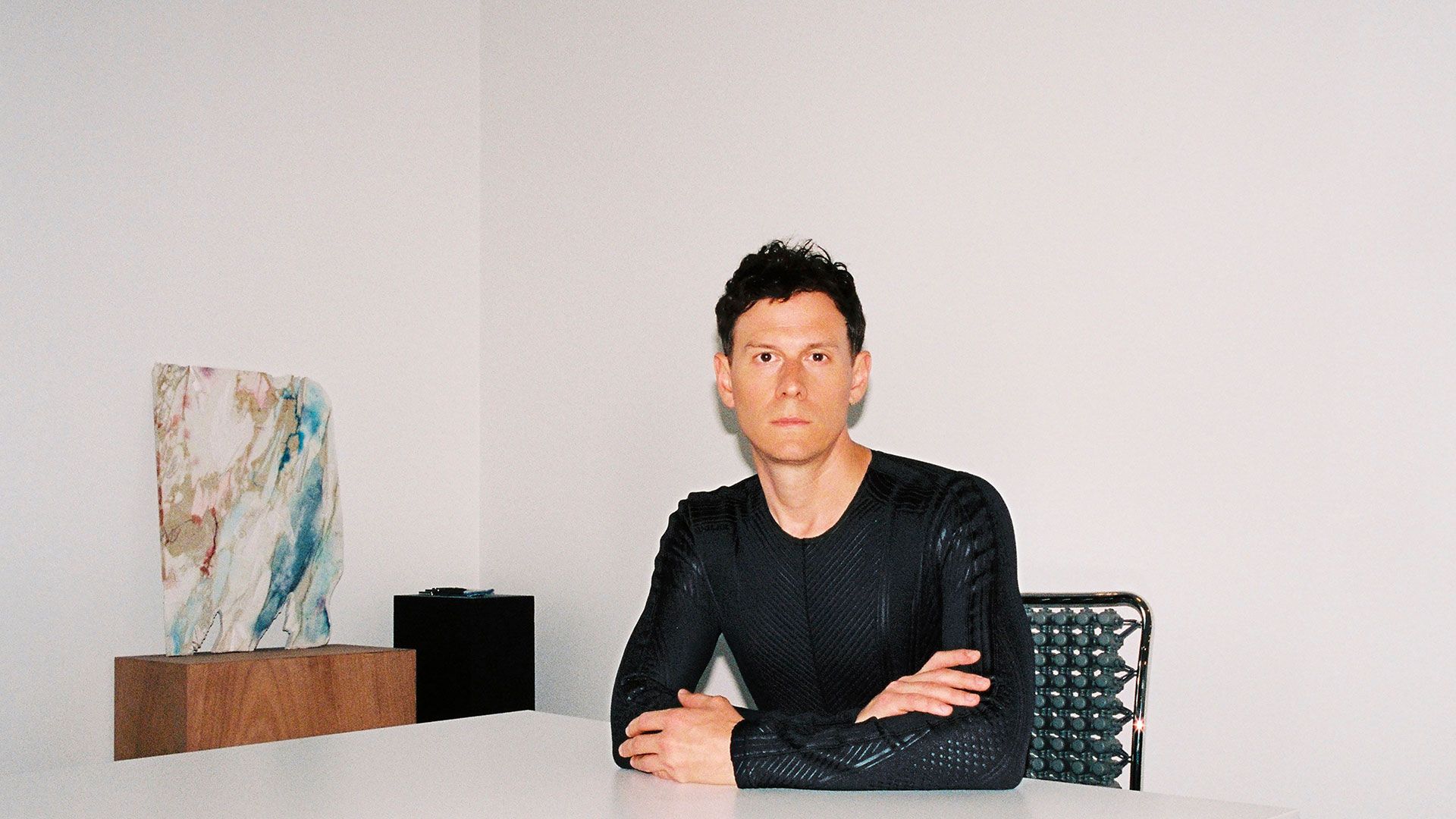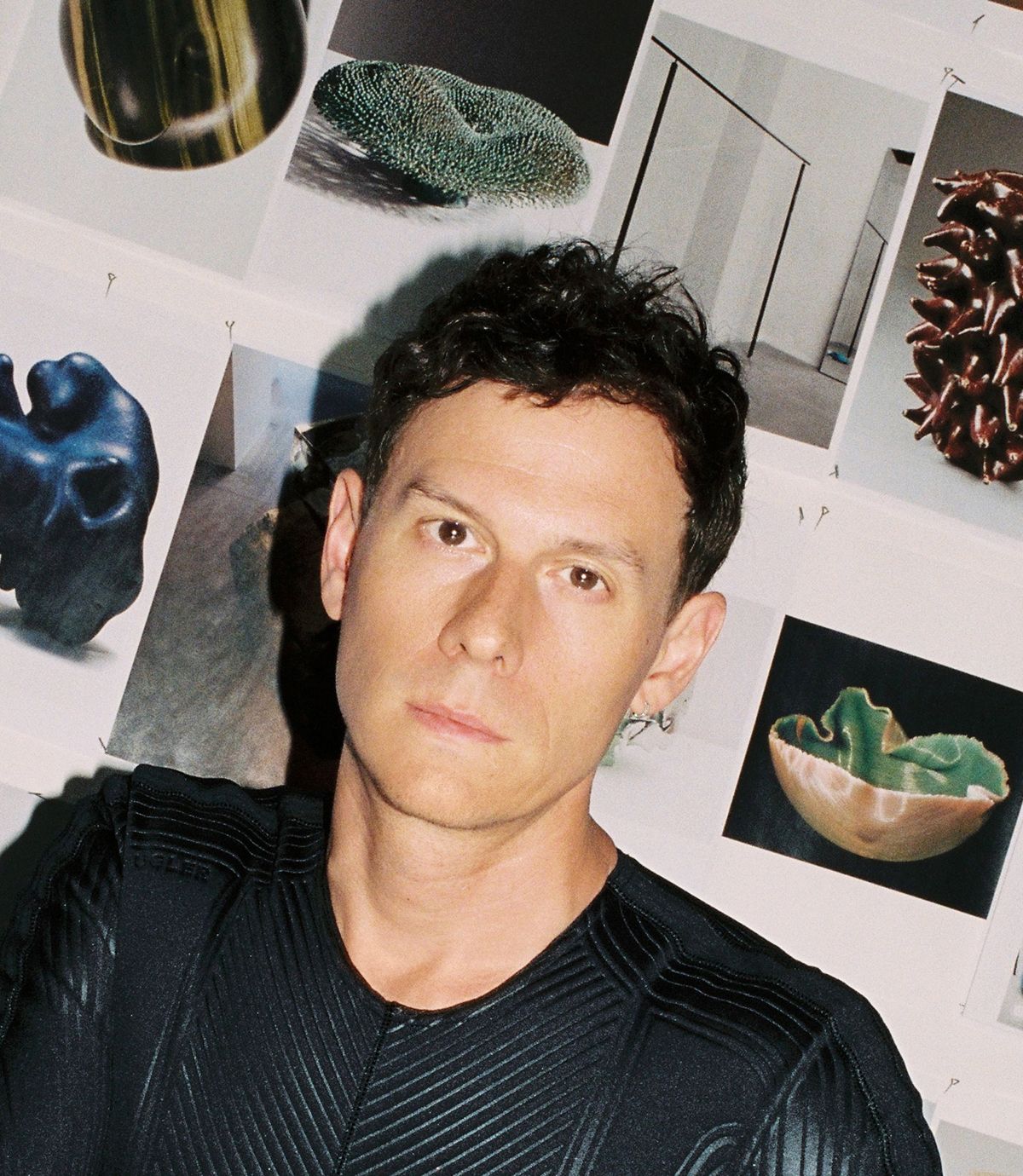-
"I want our notion of beauty to evolve": Meet Casey Cadwallader, Creative Director at Mugler

Printemps.com: Mugler was the first brand to truly hand you the reins by appointing you Artistic Director almost three years ago now. At the time, were you worried about the move and the pressure it would bring, or was that a motivating factor?
Casey Cadwallader: Both [Laughs]. At first, I found it very exciting not having a boss, but then I realized that with my job comes a lot of responsibility. But I quickly made the decision to trust myself. With this job, I learned
to just ask myself, "Do I like this? Is this really the way I want it?" If the answer is yes, then I'm on the right track. The only mistake I can make is not listening to myself.

Leather Phoenix Pants, Deadwood. T-shirt, Rick Owens. Leather Boots, Rick Owens.
You've collaborated on several dress designs with artist Samara Scott. Are there other artists you'd like to create pieces with?
Yes, many. That's one of the reasons why we only present two collections a year now rather than four. When I first arrived, I wanted to do so many things that we ended up being totally overwhelmed, to a point where I had to stop artistic
collaborations altogether even though I was doing them in the beginning. Eventually I said to myself, "What am I doing? Those collaborations are the most important aspect of this for me, I absolutely have to keep doing them." Moving forward,
we're going to get back to taking the time to do things the way we like doing them.
While we were getting settled in earlier, you explained to me that you were a coronavirus carrier early in the quarantine. Once you had recovered, which was exhausting at first, did the confinement period feel beneficial to you from a creative point of view?
It changed my life in a way. We had just designed the spring 2021 collection when the quarantine began, and it gave me a bit of extra time to devote to it. So I started working on it again, and it just got huge, and so I only kept
my favorite pieces. Usually we design a line in two to four weeks — this time we had eight. I told myself that I would keep working like that from now on. I spent a lot more time drawing and researching, and I realized that this is an
essential part of the process for me. I was really able to take the time to sit down with the work, whereas when I'm at the office I'm in meetings all the time... So I've decided to work from home at least two days a week from now on, so
I can think more deeply.
One of the themes of the artistic direction you provide at Mugler is inclusiveness. Why is this concept so important to you?
It was largely nurtured by my mother and my sister. They're both petite with large breasts and often, when they try on a piece, they're disappointed with it. I listened to them talk about it as I grew up, and reflected on it, and asked
myself where I find beauty and how I wanted to represent that. I want the notion of beauty to evolve, to become broader. I want to tell new stories instead of just making conventional things. I love so many different body types and I want
people to feel good about themselves. So I'm very interested in the development of fabrics and the technologies related to them. Recently, I've been studying how some new materials can better adapt to people's bodies. For example, using
a high-tech transparent jersey allows me to create a draped dress in a size 36 that a person who wears a size 40 can wear as well. And whether you have a larger or a smaller chest, it will always fit right. If I created that same dress
in inextensible silk, it would certainly be very beautiful, but you would need to wear a size strictly corresponding to the size and dimensions of the piece itself.

You don't shy away from flattering the feminine form with your pieces, whereas fashion still often seeks to hide them.
I've worked for brands that would sometimes hire sublime models, but whose breasts were considered too big and so they would have to make sure to hide them during the shows. I do the exact opposite. I really want to let a woman's curves
appear, because all women have different forms and many of them don't feel comfortable with those forms due to a lack of representation. By showing different sizes, different proportions, people can really feel that these clothes are designed
with them in mind.
Do your mother and sister wear the clothes you design for Mugler today?
Yes [Laughter]. They don't really like to walk around in evening wear, but they both wear jeans and sweatshirts.
Mugler has long been a brand mainly worn for special occasions, but your collections include a lot of pieces that are great for everyday wear. What drew you to this evolution?
I'm trying to find a balance. Mugler is known for its couture and evening pieces. When I arrived, I was more interested in making jeans and T-shirts in a novel way and creating clothes with a sporty or festive side, that in a way echoes
my personal interests — I do sports, I like techno, raves... Then, I felt like focusing on tailoring, too. But I was ultimately committed to expanding our paragraph fw-bolder-range rather than hanging onto that super-exclusivity, so that if a person really
wants to own a Mugler piece, it's possible for them to get one.
You regularly draw inspiration for your collections from areas outside of fashion — architecture, art, interior design... Do you always have specific references in mind when you create a new piece?
Not necessarily. A lot of things come together for me at unexpected moments. But if I think about how it happened, then I can usually pinpoint what made me choose to go in a certain direction. The color of a piece may have been inspired
by a sculpture I saw in London, while its material may have been developed in Italy, and its shape may have come to mind when I saw a certain car. I'm very interested in older, sort of tacky clothes as well, like stripper outfits or swimsuits
from the 80s, because they resonate with the Mugler aesthetic. I'm also fortunate enough to be able to consult our archives: I bring pieces in, try them on, then send them back and go back to the drawing board. The idea is to capture the
spirit of it, l'esprit, to let it function as a kind of filter. I'll create a new piece keeping the archives in mind, but I never copy them.

The casts of your campaigns and fashion shows, which bring together personalities as strong as they are diverse, also creates a bridge with the Mugler legacy by including its muses from the 90s, like Debra Shaw.
I knew from the beginning that I had to make that happen. It's as much about my respect for Mugler as for these models, who transcend the question of age. Debra came over, we talked and totally fell in love, and we ended up collaborating
on several occasions. I try to build a family that brings together those with whom I feel a strong connection — I don't choose them for their looks, but for who they really are. I don't like to pick a model and then throw them out like
other designers do. And really, I'd love to collaborate with so many other women who walked for Mugler in the early days. Having an open approach to age is essential for me. Beyond casting, it's also my approach to our clientele: I want
the granddaughter, daughter, mother and grandmother to wear Mugler. We try to create very chic pieces, ones that cover the body, and then more fun, trashy ones that you'd go clubbing in. The idea is to meet all kinds of needs.
Many of the pieces you design are gender-neutral, and you've said in past interviews that many of your masculine-identifying friends like to wear the clothes you create for Mugler's women's collections. Is this also the case for you?
Yes, I wear jeans and denim jackets, sometimes pants and some shirts. We make a lot of clothing that really sticks to the body, but I always try to make sure that we create other kinds of pieces as well. Really, I draw loads of inspiration
from the masculine world. Sometimes during the fittings, the model [editor's note: woman] will take off a piece of clothing and I'll try it on, and I'll say something like, "the shoulders are too small," because it's a piece that has to
be gender-fluid.
What is your vision for Mugler's future?
For a while we had very limited distribution — it was kind of difficult to find Mugler pieces in retail, so it's important that we continue to develop a greater presence. I'd also like to launch new product categories — footwear, more
pieces for men — and also create more couture pieces. Not in hopes of joining the official haute couture Rolodex, but really to conceive projects that require that kind of precision, because we're able to execute that, and it's in the
brand's DNA. I'm in the mood for more fantasy at the moment.
This new tendency was already apparent at your last show.
Yes, I'm getting warmed up. The Mugler house is a huge influence, as are the musical artists we collaborate with. They want the spectacular, and I want to bring it to them.